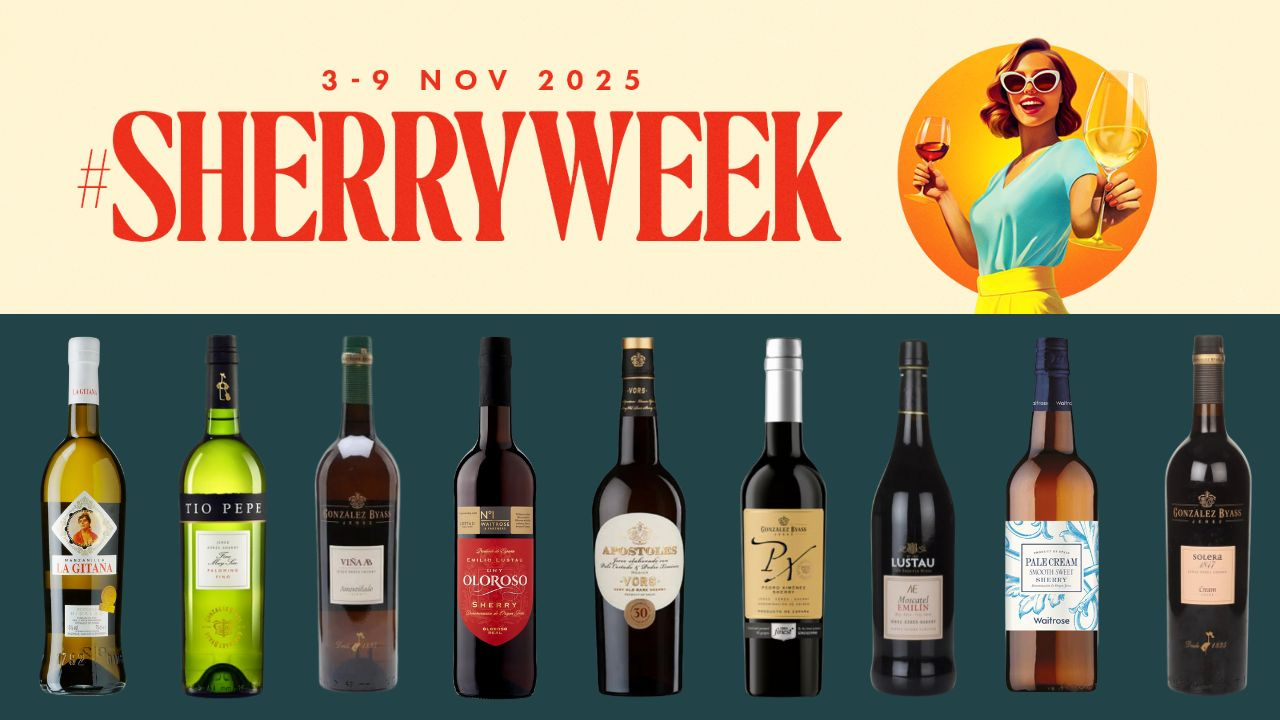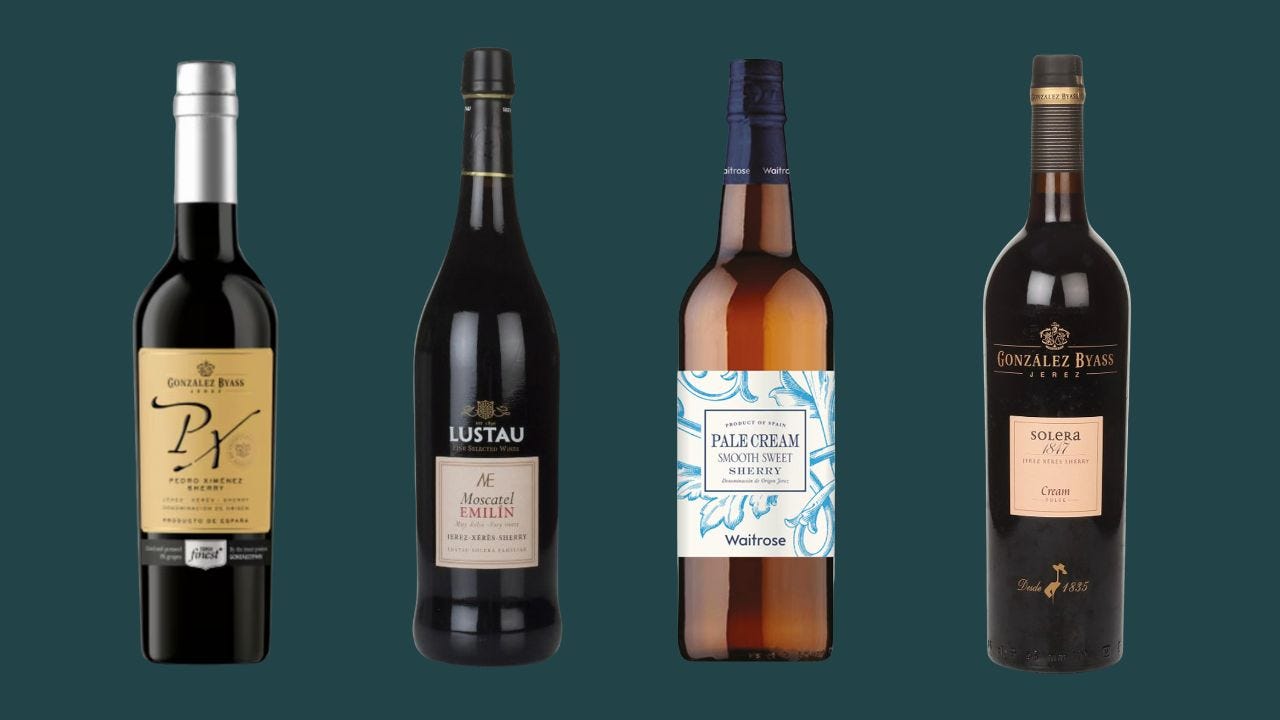As it’s officially Sherry Week, I wanted to continue to bang the drum for these moreishly saline, food friendly sippers. Here’s why it’s time to reacquaint ourselves with these unique wines from the sun-soaked vineyards of southern Spain.
Wine? Spirit? Liqueur? What exactly is Sherry?
In recent years, Sherry has had a renaissance. Younger generations discovering its charms, Sherry bars are popping up in trendy neighbourhoods worldwide and restaurant lists now boast numerous offerings. But what is it exactly? In a nutshell, Sherry is a fortified wine that hails from a triangle of villages in Spain’s Andalusia and more often than not, it is bone dry. Yes, there are several types of sweet Sherry, naturally so or not so naturally so, but when wine lovers talk about authentic Sherry, it’s the dry stuff they mean.
It all starts with Palomino Fino grapes, which are grown around the city of Jerez de la Frontera in Andalusia. Being an ‘Old World’ (European, essentially) wine style, it takes its name from the place rather than the grapes and ‘Sherry’ is just a slightly confusing English translation of ‘Jerez’.
For dry Sherries, wine is made by grapes in the normal way, with a splash of brandy or grape spirit added at the end to fortify the wine. The historical reasons for doing this were many, but the key reason was to raise the wine’s alcohol content to make it less susceptible to spoilage, especially during transportation. After all, the Andalusian climate is warm and humid, so normal wine would go off very quickly in the days before air conditioning.
What makes the dry styles of Sherry unique?
It’s what happens once the wine is fortified and put into wooden barrels that the Sherry magic happens. A small amount of space is left as the liquid ages and the region’s humidity causes a thin layer of yeast called ‘flor’ to develop on the top of the wine, which helps protect it from being completely oxidised. Whether this flor layer remains intact or not and how long it remains then defines the final style of the Sherry inside the barrel. Here’s a rundown of the five, stunningly dry Sherry styles followed by the sweeter ones:
✨ Read the full article on Substack HERE ✨
Manzanilla (15-17% abv typically)
Manzanilla is the seaside cousin of the famous Fino and has an unmistakable maritime vibe. It can only be made in the town of Sanlúcar de Barrameda and has a characteristic chamomile note (manzanilla is Spanish for chamomile). It also tends to be a touch lighter and more saline than Fino. Picture sipping the sea breeze captured in a bottle with a delightful, fresh bread yeastiness. Great with savoury snacks and salty cheeses.
Try: La Gitana Manzanilla NV, £15.50 from Waitrose
Fino (15-17% abv typically)
Fino is a similarly pale and bone-dry style that’s as crisp as a newly ironed shirt. Unlike Manzanilla, it can be produced in any of the three towns within the Sherry Triangle and has more of a roasted, salted almond note with hints of crunchy apple. A great aperitif that also loves salty snacks and can cut through fried food like a blade. It’s also awesome with tonic. Incidentally, the famously sweet ‘cream’ sherries that Granny loves are often Finos with added concentrated grape must or grape syrup.
Try: Tio Pepe Fino, £13.50 from Sainsbury’s
Amontillado (17-22% ABV typically)
While both Manzanilla and Fino are made with wines where the flor layer has stayed intact, Amontillado is what you get when flor is removed. Starting life as a Fino, it spends time ageing in barrels before having a slosh of brandy for fortification. This spirited wine then moves to a new barrel, where it begins its journey into oxidative ageing, resulting in a darker, amber colour with notes of roasted nuts, tobacco, spice and dried fruit, all the while keeping a tangy saltiness. Amontillado can also have a bit of PX (see below) added for sweetness.
Try: Gonzalez Byass Vina AB Amontillado £14.50 from The Champagne Company
Oloroso (16-20% ABV typically)
Made deliberately without any flor from the start and subjected to extensive ageing, Oloroso is the darkest dry Sherry style and is full-bodied, concentrated and complex. Silky smooth and intensely nutty in character, it has wonderfully Christmassy notes of dried raisins, figs and salted caramel. Stunning alone but it also loves mature cheeses and can handle game too.
Try: No.1 Emilio Lustau Dry Oloroso, £13.95 from Waitrose
Palo Cortado (17-22% ABV typically)
Palo Cortado is the style to ask for in a bar if you want to show off your Sherry skills. Made often unintentionally when the flor layer naturally dies away on wines destined to be Fino or Amontillado, PC combines the dryness of Amontillado with the nuttiness and body of Oloroso. Think tangy, salted almonds, hazelnuts, dried fruits, toffee, and vanilla oak. It’s what the Sherry hipsters are drinking!
Try: Apostoles Gonzalez Byass Palo Cortado, £25 (mix 6 price ) for a half bottle, Majestic
What About Sweet Sherry?
There’s nothing at all wrong with these stalwart, sweeter styles and they still sell by the truck load during the festive season; it’s just not what the Sherry revolution is about. Here are the styles to know:
Pedro Ximenez (15-17% abv typically)
PX, as it is affectionately known, is a sweet style of Sherry made with very ripe, white, Pedro Ximenez grapes, which are air dried on mats to concentrate sugars and flavours before being gently pressed. The lusciously sweet juice is then aged in barrels for a long time - sometimes decades, to achieve a thick, dark, treacley consistency and flavours of dried fig and baking spice. These are fortified early, before fermentation really begins, so sugar remains sky-high while alcohol is moderate. Stuff the chocolate sauce, pour this over your ice cream! Note: This is not the sweet ‘cream’ sherry beloved by elderly parents at Christmastime.
Try: Tesco Finest Pedro Ximenez Sherry, £7.50 from Tesco
Moscatel (15–18% abv typically)
Made from the intensely aromatic Muscat of Alexandria grape, Moscatel Sherry is all sunshine and orange blossom. The grapes are sometimes sun-dried to boost sweetness before being gently fortified, keeping plenty of natural sugar intact. Expect notes of honey, candied citrus peel and dried apricot wrapped up in a golden glow. It’s less treacly than PX - more marmalade glaze than molasses - and it works beautifully with fruit tarts or blue cheese.
Try Lustau Moscatel Emilin, £27.50 on Master of Malt
Pale Cream Sherry (15–17% abv typically)
Born from the dry, delicate world of Fino and Manzanilla, Pale Cream is made from these dry sherries sweetened with unfermented grape must to smooth the edges and go down more easily. Light straw in colour and gently floral, it has notes of bruised apple, almond and vanilla syrup. Best served chilled, it’s a bridge for those dipping their toes into the world of sherry, especially as an aperitif or alongside pâté and salted nuts.
Try Waitrose Blueprint Pale Cream Sherry, £9.95 from Waitrose
Medium Sherry (17–19% abv typically)
A halfway house between dry and sweet, Medium sherry starts life as an Amontillado or Oloroso before being softened with a touch of Pedro Ximénez or concentrated grape must. The result? A burnished amber beauty with notes of caramel, orange peel, and roasted nuts. It’s more off-dry and moreish, like the the Goldilocks of sherries: not too sweet, not too dry.
Try: Romate Don José A Selection Oloroso Medium Dry £11.50, The Wine Society
Cream Sherry (17–20% abv typically)
The classic after-dinner style, Cream sherry is a blend of rich, nutty Oloroso with luscious PX for sweetness and texture. Expect toffee, coffee, walnut and dried fruit aromas with a silky, velvety finish that lingers. It’s the ultimate fireside sip, best served with a box of quality streets or sticky toffee pudding.
Try Gonzalez Byass Solera 1847, £16.50 from Master of Malt
Let me know which styles you have tried in the comments of come and fine me on socials @helenasips. Thanks for reading!





